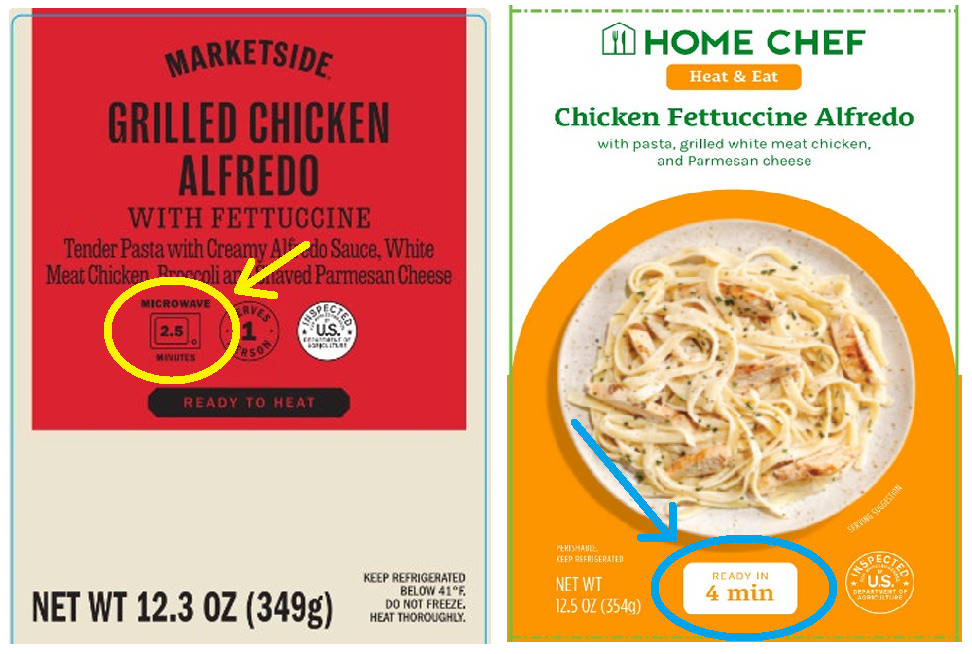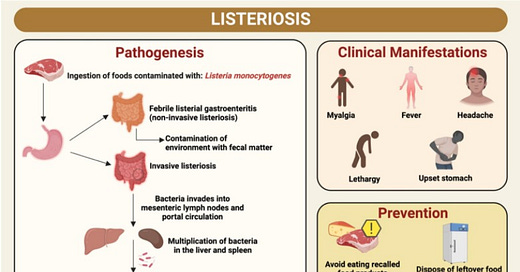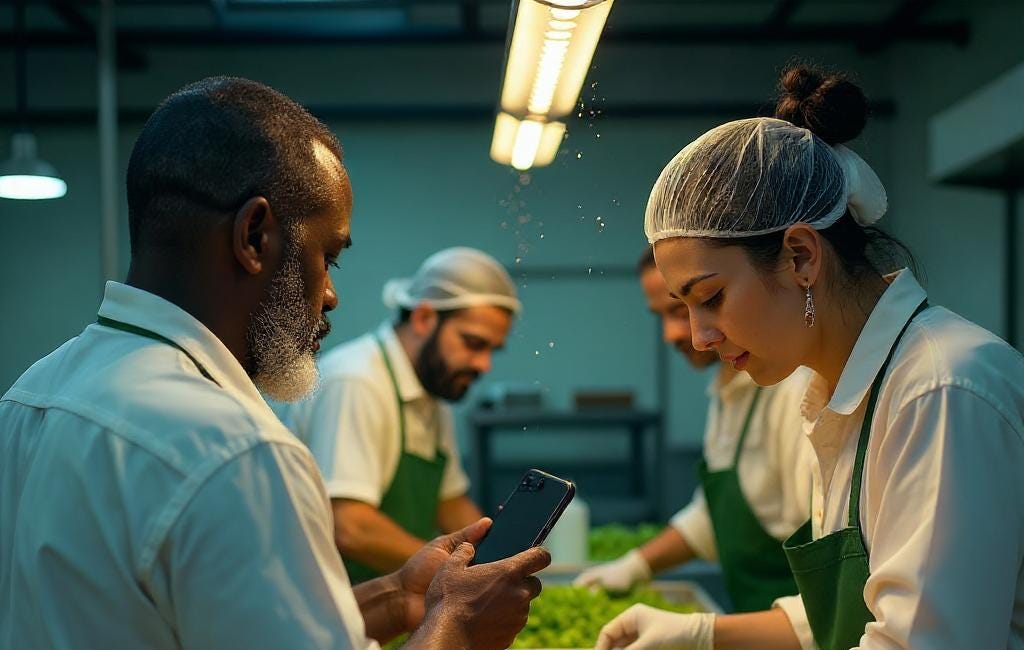This is The Rotten Apple, an inside view on food fraud and food safety for professionals, policy-makers and purveyors. Subscribe for insights, latest news and emerging trends straight to your inbox each Monday.
Unusual: a deadly Listeria outbreak and recall unpacked
Downloadable training exercise
Food Safety News and Resources
The weirdest kitchen induction video ever
Food fraud news: The Food Industry Intelligence Network launches a SME hub
Hi, Happy Monday!
Welcome to Issue 194, where I wring my hands over Listeria deaths from heat-and-eat pasta meals, discuss why the outbreak is unusual and ask how it happened.
Also this week, a downloadable training exercise for paying subscribers, and the weirdest kitchen induction video I’ve ever seen.
Plus, an introduction to the new SME (small to medium enterprise) hub created by the Food Fraud Intelligence Network, with dozens of free resources to help you keep your products safe and authentic.
Enjoy,
Karen
P.S. Big shoutout to 👏👏 Sherrilee from the UK 👏👏 for upgrading to a paid subscription. Every subscription makes a difference, thank you!
Cover image: Listeriosis infographic by Sharma, et. al (2025)
Deadly Listeria outbreak from heat-and-eat meals
Ready-to-cook chicken fettucine meals have been recalled in the United States as they may contain the outbreak strain of Listeria monocytogenes, which has so far killed 4, with 17 confirmed illnesses and 16 hospitalisations. The Food and Drug Administration (FDA), the Food Safety and Inspection Service (FSIS), and the Centers for Disease Control and Prevention (CDC) are investigating.
Not a normal recall
On the surface, this looks like an ordinary recall, with a pathogen found and products recalled.
However, this is not a new outbreak. The illnesses actually started in July last year, with 5 of the confirmed cases falling ill in 2024. The largest number of new cases was in January 2025, and the most recent case was confirmed in May 2025.

The other thing that makes this unusual is that the food is not ready-to-eat, but must be reheated before consumption. Listeria is deactivated by heat and doesn’t leave toxins in food after cooking. Consequently, listeriosis outbreaks are almost always linked to ready-to-eat foods that aren’t heated before consumption, such as sandwiches and deli meats.
The smoking gun?
In the early months of the outbreak, authorities knew the illnesses were linked, but did not know which food(s) had caused them.
Some months into the outbreak, the USDA’s Food Safety and Inspection Service (FSIS) commenced a traceback on chicken fettuccine, after some victims reported eating it. They traced the illnesses to brands sold by Walmart and Kroger and produced by the contract manufacturer FreshRealm.
In March 2025, the FSIS found the outbreak strain in a sample of FreshRealm-produced chicken fettuccine. While food from that lot was not distributed to the market, it appears that other lots continued to be produced and/or distributed by FreshRealm.
The FDA recall was announced three months later, on 18 June, and includes products produced any time before 17 June, and with best-before dates of up to 27 June.
The FSIS and FDA say they haven’t determined the source of the contamination in the product. The FDA says its testing of FDA-regulated ingredients is complete, and the outbreak strain of Listeria was not found in the ingredients.
FreshRealm appears to have continued to make product after the outbreak strain was found in their product, and before the source of the contamination was known.
The CDC said (18 June) that it “continues to see ill people reporting this specific food and is concerned that contamination is still occurring”. Wow.
Recalled products:
Marketside Grilled Chicken Alfredo with Fettuccine 12.3 oz – best-by date of June 26, 2025, or prior
Marketside Grilled Chicken Alfredo with Fettuccine 32.8 oz – best-by date of June 27, 2025, or prior
Home Chef Chicken Fettuccine Alfredo 12.5 oz – best-by date of June 19, 2025, or prior
Are consumers to blame?
Two of the three products in the recall, chicken alfredo fettucine ‘heat and eat’ meals made by the manufacturer FreshRealm for Walmart and Kroger own-brands, state “Heat thoroughly” on their front labels.
Thorough heating would eliminate Listeria, so what went wrong? Was it that consumers didn’t heat the product in accordance with instructions, or were the instructions inadequate, for example, by not properly accounting for variations in consumers’ appliances?
Or did some consumers cross-contaminate their meals, perhaps by plating up the product before microwaving, and using the same utensils afterwards, or licking a utensil used to stir the meal during heating?
Whatever led to the products not being thoroughly heated, consumer mistakes like under-heating and cross-contamination are reasonably foreseeable. And it follows that Listeria monocytogenes is a reasonably foreseeable hazard in heat-and-eat foods, at least in my book.
Two approaches to Listeria in foods that require heating
Foods that don’t require heating before eating, like bacon* (kidding, just kidding!), sandwiches, deli meats, smoked salmon and patisserie items are considered ‘ready-to-eat’ and must be free from Listeria.
Foods that must be cooked before eating aren’t subject to the same regulatory microbiological limits as ready-to-eat foods. However, many food companies acknowledge that consumers often fail to follow cooking instructions properly and set their pathogen limits accordingly.
Regulators also acknowledge the dangers of consumer misuse. In 2021, the country of Australia introduced a new food micro regulation to ensure that breaded ready-to-cook chicken products like nuggets, schnitzels, and similar items would be free from Salmonella, protecting consumers who ignored cooking instructions and ate them raw. A similar rule was introduced in the US in 2024, for stuffed breaded chicken products such as chicken Kiev.
The risks are real. In the past few years, there have been a number of recalls of frozen vegetable products for Listeria, even though such products carry warnings to cook thoroughly before eating.
Frozen veg companies that recalled their products for Listeria weren’t being over-anxious. Research published in the Journal of Food Protection earlier this year revealed that approximately 9% of American consumers consume frozen vegetables raw, and 40% do not follow cooking instructions for frozen vegetables.
What about heat-and-eat pasta meals? How many consumers don’t heat such meals enough to kill Listeria? We don’t know for sure, but this outbreak proves that at least some do not. Whether that was because the heating instructions were inadequate or they didn’t follow the instructions, we don’t yet know.
There are two approaches a food company can take regarding Listeria in heat-and-eat foods:
1) Rely on the consumer to heat or cook the food thoroughly to eliminate the pathogen.
2) Assume some consumers will not heat the food enough to eliminate Listeria and implement appropriate preventive controls so that it is not present.
In the current recall, the authorities have not revealed whether the manufacturer was relying on consumers to eliminate Listeria in its products or not. However, I did note a curious difference between two of the brands in the recall.
Wildly different prep times?
The recalled Walmart brand, Marketside, comes in a 12.3 ounce (349g) pack with instructions to microwave for 2.5 minutes. The Kroger brand, Home Chef, comes in an almost identical size, 12.5 ounces (354g), and says on the front label that it is “Ready in 4 min”.
I looked for detailed cooking instructions for both brands but could not find them online. The USDA shared front-of-pack labels.
It’s curious that similar products in similar pack sizes, from the same manufacturer, have such different prep times. Perhaps one brand owner chose a higher microwave time out of an abundance of caution. Alternatively, “Ready in 4 min” includes standing and waiting time.
Either way, the preparation instructions and cook times should have been properly validated by the manufacturer to ensure the process would eliminate pathogens.

High microbial load?
No matter whether consumer error or problematic heating instructions contributed to the outbreak, it’s worth noting that Listeria monocytogenes has a high infective dose. This means you need a lot of bacteria present to cause illness.
In healthy adults, the estimated infective dose is 10⁷–10⁹ cfu (colony forming units) per serving. In vulnerable populations, the dose is much lower. Doses as low as 8,200 CFU per serving have been linked to illness in immunocompromised individuals during outbreaks.
Assuming the worst possible infective dose, a one-person serve (349g) of contaminated pasta would still have had to contain around 20 cells of Listeria monocytogenes per gram. Using a more typical infective dose estimate for vulnerable populations of 105 per serve brings the amount to almost 300 cells (102) per gram of food.
That’s super high – the legal limits for ‘ordinary’ bacteria, not pathogens, in ready-to-eat food are typically 104 cfu per gram. The situation looks even worse if you imagine some of the victims may have partially warmed the food, potentially killing off some of the bacteria, or just licked a spoon and so consumed only a tiny portion of unheated food.
Disgusting
If you think a possible pathogen load of 104 cfu per gram seems crazy high, wait until you hear what consumers had to say about the products.
I love reading product reviews, and they can sometimes reveal ongoing quality problems in a product.
The product reviews for the Kroger brand were by far the worst I have ever read for any type of product. They reveal apparent spoilage problems, which seem to have been occurring for more than a year; include two reports of consumers claiming they were sickened by the product and a complaint that the wrong product was in the pack.
Below are some of the dozens of one-star reviews for Home Chef Heat And Eat Chicken Fettuccine Alfredo, from Kroger’s sales page. The page for the Walmart product has been taken down, so I couldn’t check its ratings.
Weird taste, couldn’t eat it. Susan, 2025-04-30
Meat had gone bad before the expiration date. Anonymous 2025-04-23
Absolutely disgusting, this is enough to make someone puke. Anonymous 2025-04-23
Hubby & I both took one bite and threw it in the trash. Both portions had a sour/spoiled/chemical taste. Melissa 2025-04-14
Had this last night and not only did it taste bad but it also had me chained to the toilet at 6am violently vomiting for two hours. Granted it was 1 day past date, but I still don't think it should be that spoiled after a day. Anonymous, 2025-01-06
Was well before expiration, heated according to instructions and it was clearly spoiled. Didn’t even taste. Had a pungent rancid smell. Anonymous 2024-11-14
This is not the product you receive. It had peas in it and you could taste the peas!! it was so gross. terrible do not recommend! Kimberly, 2024-10-01
The chicken tasted funny! Anonymous 2025-08-02
The worst thing I’ve ever tasted. Gross. Anonymous, 2024-07-29
Was sick for three days after eating this for dinner one night. Highly recommend you avoid this! Anonymous, 2024-05-26
This is disgusting, doesn't even deserve 1 star. Funky taste and smell, I have no clue what they put in it to be so awful. Kristi, 2024-05-10
Absolutely awful. Smelled during and after cooking. Tasted horrible. Double checked to make sure the expiration was good. Ate 4 bites and unable to stomach any more, Cristi, 2024-03-30
Wouldn’t feed it to my dog, the alfredo sauce had an awful flavour and the chicken pieces were basically mush. Couldn’t take more than two bites before tossing it, Elaine. 2024-02-27
One-star reviews accounted for 23 of the 30 reviews for this product, giving it an overall rating of 1.7 stars.
Final thoughts
One death is too many. Four deaths – four preventable deaths – are unthinkable.
At this time, we don’t know if consumers were sickened after they diligently followed the preparation instructions, or if consumer error was involved in this outbreak, but since consumer misuse is likely for heat-and-eat products, Listeria should not have been present in the products either way.
Reviews of one of the products involved in the recall seem to indicate long-term problems with microbial contamination, with consumers reporting spoilage issues for more than one year.
How could high-value brands like Kroger and Walmart, with access to the best technical resources in the United States, allow what appears to be grossly contaminated product to get to their consumers? It’s shocking.
In short: Four deaths and multiple hospitalizations from listeriosis have been linked to heat-and-eat chicken pasta meals, with authorities finding the outbreak strain in at least one lot of product 🍏 Illnesses started in July 2024, the outbreak strain was found in product in March 2025 and the recall commenced in June 2025 🍏 This is an unusual recall because thorough heating should eliminate Listeria. It is not known if there were problems with the heating instructions or if consumers did not follow them correctly 🍏 Consumer misuse is reasonably foreseeable, and for that reason, pathogens like Listeria should be absent from heat-and-eat products like the ones being recalled 🍏
Sources:
Listeria Outbreak Linked to Chicken Fettuccine Alfredo Meals | Listeria Infection | CDC
Outbreak Investigation of Listeria monocytogenes: Chicken Fettuccine Alfredo Meals (June 2025) | FDA
*Imagine my horror when I discovered that my son (then aged ten) secretly loved eating bacon raw, straight from the fridge🤢
Downloadable Training Exercise
Download a training exercise based on the food safety day competition in Issue 191 by clicking the preview box below. For paying subscribers.
Food Safety News and Resources
Our food safety news and resources roundups are expertly curated and never boring.
This week’s roundup is packed with new food safety research and reviews.
Click the preview box below to access it.
The Weirdest Kitchen Induction Ever
This might be the strangest instructional video I’ve ever seen. In it, two middle-aged men wearing dresses kick things, blow things up and simulate odd cooking practices in a parking lot while two jaded teens look at their phones. All in the name of food safety.
I don’t know whether I love it or hate it (but I did enjoy the soundtrack!)
What about you? Love it or hate it?
📌 Food Fraud News 📌
The Food Industry Intelligence Network (FIIN) launches a SME hub
The Food Industry Intelligence Network is an industry-led consortium established in 2015 to collect, analyse, and disseminate intelligence on food authenticity and fraud risks. It acts as a safe haven for food businesses to anonymously share food fraud information about specific foods and supply chains, enabling targeted intelligence-sharing and assisting in the fight against food fraud.
FIIN recently launched a SME hub for small to medium enterprises, which includes practical tools, guidance and training materials (and this newsletter)!
The FIIN SME hub offers
Fiin's quarterly commodity watchlist - based on over 50,000 authenticity tests
Food fraud definitions & examples - clear explanations and real-world illustrations
Fraud prevention guides & training materials - practical, SME-friendly tools
News & events - updates and events relevant to food fraud
Food fraud reporting channels - know where and how to report concerns.
All resources are free and tailored specifically to meet the needs of SMEs across the food sector.






